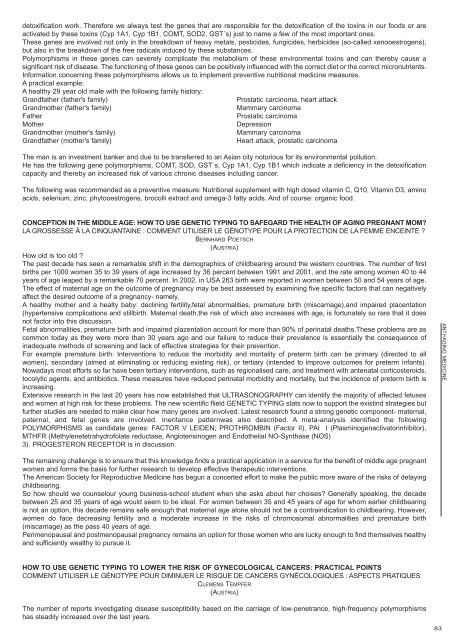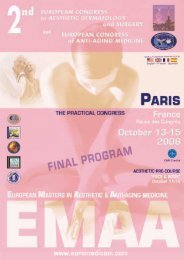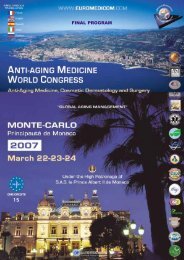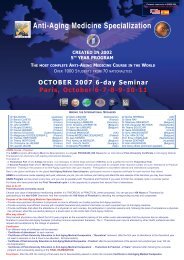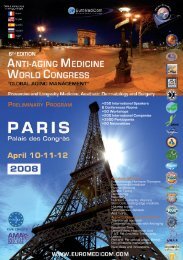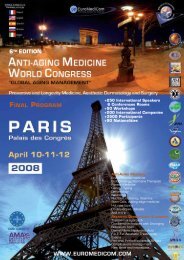FINAL PROGRAM 6TH EDITION - EuroMediCom
FINAL PROGRAM 6TH EDITION - EuroMediCom
FINAL PROGRAM 6TH EDITION - EuroMediCom
You also want an ePaper? Increase the reach of your titles
YUMPU automatically turns print PDFs into web optimized ePapers that Google loves.
detoxification work. Therefore we always test the genes that are responsible for the detoxification of the toxins in our foods or areactivated by these toxins (Cyp 1A1, Cyp 1B1, COMT, SOD2, GST´s) just to name a few of the most important ones.These genes are involved not only in the breakdown of heavy metals, pesticides, fungicides, herbicides (so-called xenooestrogens),but also in the breakdown of the free radicals induced by these substances.Polymorphisms in these genes can severely complicate the metabolism of these environmental toxins and can thereby cause asignificant risk of disease. The functioning of these genes can be positively influenced with the correct diet or the correct micronutrients.Information concerning these polymorphisms allows us to implement preventive nutritional medicine measures.A practical example:A healthy 29 year old male with the following family history:Grandfather (father's family)Prostatic carcinoma, heart attackGrandmother (father's family)Mammary carcinomaFatherProstatic carcinomaMotherDepressionGrandmother (mother's family)Mammary carcinomaGrandfather (mother's family)Heart attack, prostatic carcinomaThe man is an investment banker and due to be transferred to an Asian city notorious for its environmental pollution.He has the following gene polymorphisms, COMT, SOD, GST´s, Cyp 1A1, Cyp 1B1 which indicate a deficiency in the detoxificationcapacity and thereby an increased risk of various chronic diseases including cancer.The following was recommended as a preventive measure: Nutritional supplement with high dosed vitamin C, Q10, Vitamin D3, aminoacids, selenium, zinc, phytooestrogens, brocolli extract and omega-3 fatty acids. And of course: organic food.CONCEPTION IN THE MIDDLE AGE: HOW TO USE GENETIC TYPING TO SAFEGARD THE HEALTH OF AGING PREGNANT MOM?LA GROSSESSE À LA CINQUANTAINE : COMMENT UTILISER LE GÉNOTYPE POUR LA PROTECTION DE LA FEMME ENCEINTE ?BERNHARD POETSCH(AUSTRIA)How old is too old ?The past decade has seen a remarkable shift in the demographics of childbearing around the western countries. The number of firstbirths per 1000 women 35 to 39 years of age increased by 36 percent between 1991 and 2001, and the rate among women 40 to 44years of age leaped by a remarkable 70 percent. In 2002, in USA 263 birth were reported in women between 50 and 54 years of age.The effect of maternal age on the outcome of pregnancy may be best assessed by examining five specific factors that can negativelyaffect the desired outcome of a pregnancy- namely,A healthy mother and a healty baby: declining fertility,fetal abnormalities, premature birth (miscarriage),and impaired placentation(hypertensive complications and stillbirth. Maternal death,the risk of which also increases with age, is fortunately so rare that it doesnot factor into this discussion.Fetal abnormalities, premature birth and impaired plazentation account for more than 90% of perinatal deaths.These problems are ascommon today as they were more than 30 years ago and our failure to reduce their prevalence is essentially the consequence ofinadequate methods of screening and lack of effective strategies for their prevention.For example premature birth: Interventions to reduce the morbidity and mortality of preterm birth can be primary (directed to allwomen), secondary (aimed at eliminating or reducing existing risk), or tertiary (intended to improve outcomes for preterm infants).Nowadays most efforts so far have been tertiary interventions, such as regionalised care, and treatment with antenatal corticosteroids,tocolytic agents, and antibiotics. These measures have reduced perinatal morbidity and mortality, but the incidence of preterm birth isincreasing.Extensive research in the last 20 years has now established that ULTRASONOGRAPHY can identify the majority of affected fetusesand women at high risk for these problems. The new scientific flield GENETIC TYPING stats now to support the existind strategies butfurther studies are needed to make clear how many genes are involved. Latest research found a strong genetic component- maternal,paternal, and fetal genes are involved. Ineritance patternwas also described. A meta-analysis identified the followingPOLYMORPHISMS as candidate genes: FACTOR V LEIDEN; PROTHROMBIN (Factor II), PAI I (Plasminogenactivatorinhibitor),MTHFR (Methylenetetrahydrofolate reductase, Angiotensinogen and Endothelial NO-Synthase (NOS)3). PROGESTERON RECEPTOR is in discussion.ANTI-AGING MEDICINEThe remaining challenge is to ensure that this knowledge finds a practical application in a service for the benefit of middle age pregnantwomen and forms the basis for further research to develop effective therapeutic interventions.The American Society for Reproductive Medicine has begun a concerted effort to make the public more aware of the risks of delayingchildbearing.So how should we counselour young business-school student when she asks about her choises? Generally speaking, the decadebetween 25 and 35 years of age would seem to be ideal. For women between 35 and 45 years of age for whom earlier childbearingis not an option, this decade remains safe enough that maternal age alone should not be a contraindication to childbearing. However,women do face decreasing fertility and a moderate increase in the risks of chromosomal abnormalities and premature birth(miscarriage) as the pass 40 years of age.Perimenopausal and postmenopausal pregnancy remains an option for those women who are lucky enough to find themselves healthyand sufficiently wealthy to pursue it.HOW TO USE GENETIC TYPING TO LOWER THE RISK OF GYNECOLOGICAL CANCERS: PRACTICAL POINTSCOMMENT UTILISER LE GÉNOTYPE POUR DIMINUER LE RISQUE DE CANCERS GYNÉCOLOGIQUES : ASPECTS PRATIQUESCLEMENS TEMPFER(AUSTRIA)The number of reports investigating disease susceptibility based on the carriage of low-penetrance, high-frequency polymorphismshas steadily increased over the last years.83


